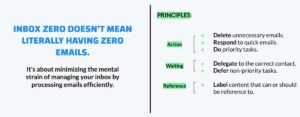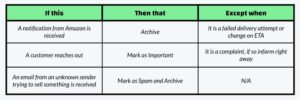For most entrepreneurs, the inbox is a battlefield—a relentless onslaught of emails, messages, and notifications that can easily dominate your day. It’s a constant tug-of-war between what’s urgent and what’s important, often pulling you away from the tasks that actually drive your business forward. But what if I told you there’s a way to reclaim your time, sharpen your focus, and significantly boost your productivity? The solution lies in delegating your inbox to an Executive Assistant (EA).
Delegating your inbox to an Executive Assistant can drastically improve your productivity and focus. Follow these key steps to set up an efficient system where your EA manages your email, freeing you to concentrate on what truly matters in your business.
- Set Up a Dedicated Communication Channel: Establish an exclusive communication tool for you and your EA to streamline inbox management.
- Develop a Rules Engine: Create guidelines for your EA on how to handle different types of emails, ensuring important messages reach you.
- Implement a Daily Check-In Routine: Have your EA send a daily summary of urgent emails, your schedule, and pending tasks.
- Empower Your EA to Delegate Tasks: Allow your EA to assign tasks to the appropriate team members, freeing up your time.
- Regularly Review and Adjust the System: Schedule weekly reviews to refine the inbox management process and ensure ongoing efficiency.
The Inbox Problem: Why You Need to Delegate
Before diving into the “how,” it’s crucial to understand the “why.” Your inbox, while a necessary tool, is often a source of distraction and stress. According to studies, the average person checks their email 15 times per day or about every 37 minutes. This constant checking is not only a productivity killer but also a source of anxiety. The more time you spend in your inbox, the less time you have for strategic thinking, creative work, and making decisions that actually grow your business.
Moreover, most of the emails in your inbox don’t directly contribute to your goals. They’re other people’s priorities, other people’s problems, and other people’s to-do lists. By the time you’ve waded through them all, your energy and focus are depleted, leaving little left for what truly matters.
This is where an Executive Assistant comes in. By delegating your inbox to an EA, you can shift your focus back to the high-value activities that only you can do. Here’s how to make that transition effectively.

Achieving Inbox Zero: The Pinnacle of Effective Inbox Delegation
As you embark on the journey of delegating your inbox to an Executive Assistant, there’s one ultimate goal that can elevate your productivity to new heights: achieving Inbox Zero. Inbox Zero isn’t just a strategy; it’s a mindset—a commitment to keeping your inbox organized, focused, and free of clutter so that you can dedicate your energy to what truly matters.
But here’s the thing: reaching and maintaining Inbox Zero becomes exponentially easier when you have a capable EA by your side. In fact, Inbox Zero should be seen as the natural outcome of effectively delegating your inbox management.
Why Inbox Zero Matters in the Context of Delegation
When you delegate your inbox to an EA, the objective isn’t just to reduce the number of emails you personally handle. The ultimate aim is to create a system where your inbox is constantly managed, prioritized, and cleaned out, allowing you to operate with clarity and focus. Achieving Inbox Zero with the help of your EA means that:
- You Start Each Day with a Clean Slate: With Inbox Zero, you begin your day focused on your priorities, not bogged down by yesterday’s unresolved emails.
- Your EA Keeps You Focused: By managing your inbox and filtering out the noise, your EA helps you concentrate on high-impact tasks rather than getting sidetracked by less important emails.
- Your Email System Is Streamlined: A well-managed inbox means that your EA is continually filtering, archiving, and organizing emails so that only the most relevant messages reach you.

Step 1: Establish a Dedicated Communication Channel
One of the first steps in delegating your inbox is to set up a dedicated communication channel between you and your EA. This channel will be your lifeline, the place where you can communicate efficiently without the noise of other distractions.
Why It Matters: Having a dedicated channel ensures that your EA has a direct line to you without getting lost in the chaos of your regular inbox or messaging apps. It’s a clear, uncluttered space where you can focus on essential communication without interruption.
How to Set Up Dedicated Communication Channel With Your Assistant:
- Choose the Right Tool: Select a communication tool that works best for both you and your EA. Popular options include Slack, WhatsApp, or even a lesser-known app like Line, which you use exclusively with your EA. The key is that this tool is used only for communication between you two.
- Set Clear Expectations: From the outset, make it clear what types of messages should be sent through this channel. Is it for urgent issues only, or can it also be used for daily check-ins? Setting expectations early will help streamline your communication.
- Consistency is Key: Use this channel consistently and exclusively for communication with your EA. This consistency helps reinforce the importance of this tool as the primary method for managing your inbox and other delegated tasks.
Pro Tip: If you prefer voice communication, consider using a messaging app that supports voice notes. This allows you to quickly send instructions or feedback without needing to type out long messages. Voice notes can be more personal and nuanced, making it easier to convey your exact thoughts and intentions.

Step 2: Develop a Robust Rules Engine
Once you’ve established a communication channel, the next critical step is to create a rules engine for your EA to follow when managing your inbox. This is essentially a set of guidelines that dictates how different types of emails should be handled.
Why It Matters: A rules engine is the backbone of effective inbox delegation. It ensures that your EA knows exactly how to handle each type of email, minimizing the need for constant clarification and decision-making on your part. This system empowers your EA to act autonomously while still aligning with your expectations.
How to Build Inbox Delegation Rules Engine:
- Categorize Your Emails: Start by categorizing your emails into different types. Common categories include client inquiries, vendor communications, internal team messages, newsletters, and spam. Once you’ve identified these categories, you can create specific rules for each one.
- Define the Rules: For each category, decide what action your EA should take. For example:
- Client Inquiries: If the email is from a VIP client, forward it to you immediately with a note about its urgency.
- Vendor Communications: If it’s routine or something your EA can handle, they should reply directly without involving you.
- Internal Team Messages: If the email is not time-sensitive, your EA can flag it for your review later. If it’s urgent, they can notify you via your dedicated communication channel.
- Newsletters and Spam: Automatically filter and archive these. Your EA can set up filters in your email client to ensure that these types of emails don’t clutter your inbox.
- Set Priorities: Not all emails are created equal. Work with your EA to establish a hierarchy of importance. For instance, emails from key clients or partners might be top priority, while internal updates can wait.
Pro Tip: Regularly review and update your rules engine. As your business evolves, so will the types of emails you receive. Periodically revisiting these rules ensures that they remain relevant and effective.
Step 3: Implement a Daily Check-In Routine
A daily check-in with your EA is crucial to staying on top of your inbox without getting dragged into it. This check-in should provide you with a quick overview of what’s important, what’s been handled, and what requires your attention.
Why It Matters: Daily check-ins allow you to stay informed without getting overwhelmed. They give you a snapshot of your day, helping you prioritize your time and energy more effectively.
How to Structure Daily Check-in Routine for Inbox Delegation:
- Morning Summary: Each morning, your EA should send you a summary of your inbox. This summary should include:
- A list of urgent emails that need your attention.
- A brief overview of your schedule for the day.
- Any tasks or follow-ups that are pending.
- Highlight Urgent Matters: If there are critical issues that need immediate attention, your EA should highlight these at the top of the summary. This ensures that you can address them first thing, before diving into other tasks.
- Provide Context: For each email or task, your EA should provide a brief context. This helps you understand the significance of the message without needing to read through the entire email.
Pro Tip: Consider scheduling a brief 5-10 minute call with your EA each morning. This allows for a quick discussion of the day’s priorities and any potential issues. It’s also an opportunity for your EA to ask questions or get clarification on tasks.

Step 4: Empower Your EA to Delegate Tasks
As your EA becomes more familiar with your business and inbox, they should begin to take on more responsibility for delegating tasks. This is where your EA truly becomes an extension of you, ensuring that the right people are handling the right tasks without your direct involvement.
Why It Matters: Delegation is a force multiplier. By empowering your EA to delegate tasks to other team members or departments, you free up even more of your time for high-level activities.
How to Implement It:
- Map Out Responsibilities: Work with your EA to create a map of who handles what in your business. This includes team members, departments, and even external vendors. This map will serve as a reference for your EA when delegating tasks.
- Create Delegation Guidelines: Just as you created a rules engine for handling emails, develop guidelines for task delegation. For example:
- Technical Issues: Forward to the IT team.
- Billing Inquiries: Forward to the finance department.
- Client Feedback: Forward to the account manager.
- Trust and Empowerment: Trust is key. As your EA proves their capability, give them more autonomy to delegate tasks without needing your approval every time. This empowerment not only increases efficiency but also boosts your EA’s confidence and job satisfaction.
Pro Tip: Encourage your EA to use their judgment. Sometimes, a task might not fit neatly into a predefined category. In these cases, your EA should feel empowered to make decisions based on their understanding of your priorities.
Step 5: Regularly Review and Adjust the System
Delegating your inbox is not a set-it-and-forget-it process. It requires regular review and adjustment to ensure it remains effective and aligned with your goals.
Why It Matters: As your business grows and evolves, so too will the demands on your inbox. Regular reviews ensure that your inbox management system remains efficient and effective.
How to Conduct Reviews For Inbox Delegation:
- Weekly Check-Ins: Schedule a weekly meeting with your EA to review how the inbox management system is working. Discuss any challenges, successes, and areas for improvement.
- Evaluate the Rules Engine: During these check-ins, evaluate the rules engine. Are there any new categories that need to be added? Are some rules no longer relevant? Adjust as necessary to keep the system streamlined.
- Feedback Loop: Create a feedback loop with your EA. Encourage them to share their insights and suggestions for improving the process. Often, your EA will have valuable input based on their day-to-day experience managing your inbox.
Pro Tip: Document changes to your system. Keeping a log of adjustments ensures that both you and your EA have a clear record of what’s been implemented and why. This documentation can be invaluable if you ever need to onboard a new EA or if you’re scaling your business operations.
Logistics: How to Grant Delegated Inbox Access in Gmail

Delegating your Gmail inbox to an Executive Assistant (EA) is a smart way to streamline email management. With Gmail’s delegated inbox feature, your EA can manage your emails directly without needing your login credentials. Here’s how to set it up.
Steps to Delegate Gmail Inbox Access to an Executive Assistant
- Log Into Your Gmail Account: Start by logging into the Gmail account you want to delegate.
- Go to Settings: Click the gear icon in the top right corner, then select “See all settings.”
- Navigate to the Accounts and Import Tab: In the settings menu, click on the “Accounts and Import” tab. In Google Workspace, the tab is usually labeled “Accounts” instead of “Accounts and Import.”
- Grant Access to Your Account: Scroll to the “Grant access to your account” section and click “Add another account.”
- Enter Your EA’s Email Address: Input your EA’s Gmail address and click “Next Step,” then “Send email to grant access.”
- EA Accepts the Request: Your EA will receive an email invitation. They should click the link to accept and gain access.
- EA Accesses Your Inbox: Your EA can now switch between their inbox and yours by selecting your email address from the drop-down menu under their profile picture.
- Manage Access: To revoke or manage access, return to the “Accounts and Import” tab and modify access as needed.

The Long-Term Benefits of Inbox Delegation
By now, you should have a solid understanding of how to delegate your inbox effectively. But let’s talk about the long-term benefits. When you delegate your inbox, you’re not just freeing up time—you’re fundamentally changing how you operate your business.
Increased Productivity: With your EA handling the majority of your email traffic, you can focus your time and energy on high-impact activities. This increased productivity translates directly into business growth and success.
Reduced Stress: Your inbox is no longer a source of stress. Knowing that your EA is managing your communication allows you to start each day with a clear mind, ready to tackle your most important tasks.
Better Decision-Making: With more time to focus on strategic thinking, you’ll make better decisions. You’ll have the mental space to consider your options, evaluate risks, and plan for the future.
Scalability: As your business grows, so will the demands on your time. By delegating your inbox, you create a scalable system that can handle increased communication without overwhelming you.
Conclusion: Take the First Step Today
Delegating your inbox to an Executive Assistant is a game-changer. It’s not just about reducing your workload—it’s about reclaiming your time, sharpening your focus, and driving your business forward. The steps outlined in this guide provide a clear roadmap for effective delegation, ensuring that your EA becomes a valuable partner in your success.
So, take the first step today. Set up that dedicated communication channel, develop your rules engine, and start training your EA to manage your inbox with precision and care. The sooner you do, the sooner you’ll experience the freedom and productivity that comes with effective delegation.
Remember, your inbox is not your to-do list. It’s time to take back control and focus on what truly matters in your business.
Pareto Talent assistants are expertly trained in advanced email management, including Inbox Zero and Gmail delegation, ensuring they’re ready to streamline your inbox from day one. Schedule a discovery call with us to get started with your Executive Assistant!
 Kasim Aslam
Kasim Aslam